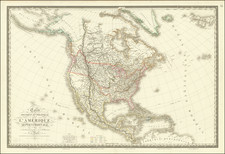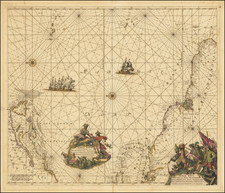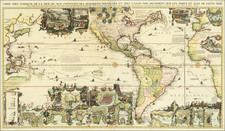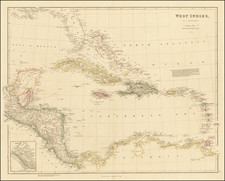Halley's Isogonic Chart of the Atlantic Ocean
Important chart of the Atlantic Ocean, illustrating Edmund Halley's discoveries regarding magnetic variation of the compass in 1700-01 and revised by new observations in 1744.
Nice example of Sir Edmund Halley's famed Isogonic Map of the Atlantic, which was the first chart to show the magnetic variations of the compass. As there is a perpetual slow change in the variation, this state has been updated through 1744. The chart includes two side panels of text with instructions on how to use the chart.
Issued by the London firm of Mount & Page, the boldly engraved chart shows the Atlantic Coasts of the Americas, Europe and Africa and has colorful place names such as "Wild Brazile" and "The Icey Sea.?
Edmund Halley was one of the most celebrated English Scientists of his time and is perhaps best known for the discovery of the famous comet that bears his name. From 1698-1700 he sailed on the H.M.S. Paramore on a voyage through the North and South Atlantic gathering the earliest systematic recordings of the magnetic variations of the compass.
The present sea chart appeared in Mount & Page's English Pilot, one of the most important and commercially successful sea atlases of the 18th Century. The map and accompanying texts were intended to provide a mariners with a basic understanding of magnetic variance, as a means of helping understand the principal while taking practical measurements at sea.
Edmund Halley and Magnetic Variation
Edmund Halley's role in the development of navigational charts in the early 18th century was pivotal, specifically in relation to the understanding and mapping of magnetic variation. The text describes the findings of Halley concerning the variation of the compass, which is the difference between the magnetic north to which a compass points and the true north.
Halley is celebrated for his scientific expedition funded by the British government in 1700, during which he gathered data on the magnetic variation in the Atlantic Ocean. The text refers to the "Curve-Lines drawn over the several Seas," which are isogonic lines, also known as Halleyan lines, indicating areas of equal magnetic variation on the chart. These lines were revolutionary at the time and greatly improved the accuracy of navigation at sea.
His voyage aboard the HMS Paramour was particularly aimed at understanding the laws governing the magnetic compass, which was an essential tool for maritime navigation. By systematically measuring the magnetic variation across different points in the oceans, Halley was able to produce the first chart of its kind in 1701, depicting the lines of equal magnetic variation. This was a crucial step forward in navigation because it allowed seafarers to correct their compass readings and determine their true heading more accurately.
Halley's chart and his method of depicting magnetic variation were significant discoveries. They not only enhanced the safety and efficiency of sea travel but also contributed to the broader scientific understanding of the Earth's magnetic field. His work laid the foundation for geomagnetism as a scientific study and remains a critical aspect of navigation and Earth sciences to this day.
The text on the map notes:
The Curve Lines which are drawn over the Seas in this Chart, do shew at one View all the places where the Variation of the Compass is the same; The Numbers to them shew how many degrees the Needle declines either Eastward. or Westward from the true North; And the Double Line passing near Bermudas and the Island Fardinando is that where the Needle stands true without Variation.
Edmund Halley (ca. 1656-1742) was one of Britain’s foremost astronomers and natural philosophers. He was also an explorer and mapmaker famous for his voyages to study magnetic variation. Edmund was born in Shoreditch, London. After the Great Fire of 1666, his family moved to Winchester Street, near where the Royal Society, one of the world’s first scientific societies, then had its rooms.
Halley began his astronomical observations as a schoolboy at St. Paul’s School and later at Queen’s College, Oxford. By the time he left Oxford, he had already written three scientific papers and was in touch with the foremost minds in Europe, including the architect Christopher Wren, the natural philosopher Robert Hooke, and fellow astronomers, John Flamsteed, Jean Dominique Cassini, and Johann Hevelius.
Halley left Oxford without a degree because he wanted to travel to St. Helena to determine the positions of the southern stars and to observe the Transit of Mercury, a project he embarked on with the support of Charles II and the East India Company. Although not entirely successful, the star chart he published as a result earned him Fellowship in the Royal Society. In 1680, Halley and a school friend embarked on a scientific Grand Tour of Europe, observing, en route, the first appearance of a bright comet.
He discussed this comet with Isaac Newton upon his return. Halley struck up a great friendship with Newton and oversaw the publication of Newton’s masterpiece, Philosphiae naturalis principia mathematica (1687). Halley wrote the Latin preface to the work, the most important in the field of physics ever published.
In the 1680s, Halley became interested in magnetic variation. As part of these studies, he produced one of his first known maps, a chart of the trade winds, the first such meteorological chart of its kind. To gather more data on the worldwide phenomena, Halley gathered information about winds and magnetic variation from a global network and took to the sea himself to make surveys and observations. In 1689 he presented a chart of the Thames approaches to the Royal Society. In 1691, he improved the design of a diving bell to help with the salvage of a cargo of gold and ivory.
Halley’s interest in sailing and charting continued in the 1690s, even as he worked as warden to the country mint at Chester. He published a flurry of scientific papers in this decade on topics including life expectancy, optics, rainbows, thermometers, and barometers. Most influential of his work for this time, he calculated the orbit of 24 comets and concluded that comets like the one he saw while on the Grand Tour have elliptical orbits. He also explained that the comet of 1682 had a return period of roughly 75 years; this comet was later named for Halley.
In 1698, Halley was given command of the purpose-built Royal Naval ship the Paramore. He set sail for the South Atlantic to make observations of magnetic variation. He embarked on a second cruise in 1699, also to the South Atlantic. These two voyages served as the basis for a chart of magnetic variation that covered the entire Atlantic, the first surviving chart to use isogonic lines and one of the first thematic charts ever produced. In 1701, Halley took the Paramore on a final cruise in the English Channel, which resulted in another chart that was a vast improvement on previous Channel charts.
Upon outbreak of the War of Spanish Succession, Halley was charged with surveying on behalf of England, a role which took him to the Adriatic. After completing his work there, he returned to an appointment as Savilian Professor of Geometry at Oxford. One of his major projects while there was to publish Flamsteed’s star charts, a project which contributed to the already stormy relationship between the men. In 1715, Halley drew a map of totality for a rare solar eclipse that would pass through London; his observations were still being used by astronomers in the twentieth century. In 1721, he succeeded Flamsteed as the second Astronomer Royal and moved to Greenwich, where he was concerned with the saronic cycle of the moon and, as ever, comets. He died there in 1742.









![[Martinique, Guadaloupe, Dominica and Marie Galante] . Suite des Isles Antilles 2. Partie](https://storage.googleapis.com/raremaps/img/small/81614.jpg)




